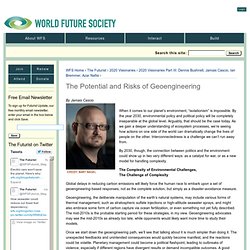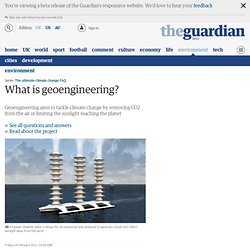

The Potential and Risks of Geoengineering. By Jamais Cascio When it comes to our planet’s environment, “isolationism” is impossible.

By the year 2030, environmental policy and political policy will be completely inseparable at the global level. Arguably, that should be the case today. As we gain a deeper understanding of ecosystem processes, we’re seeing how actions on one side of the world can dramatically change the lives of people on the other. Interconnectedness is a challenge we can’t run away from. By 2030, though, the connection between politics and the environment could show up in two very different ways: as a catalyst for war, or as a new model for handling complexity.
The Complexity of Environmental Challenges, The Challenge of Complexity Global delays in reducing carbon emissions will likely force the human race to embark upon a set of geoengineering-based responses, not as the complete solution, but simply as a disaster-avoidance measure. Letters: Geoengineering risks and the merits of proven solar technologies. Are we at risk from rogue geoengineering. As part of the Global Risks 2013 report, the World Economic Forum’s Risk Response Network has identified five “X Factor” risks in partnership with Nature.

These look beyond mainstream risks to five emerging potential game-changers. In response to growing concerns about climate change, scientists are exploring ways in which they could, with international agreement, manipulate the Earth’s climate. But what if this technology were to be hijacked by a rogue state or individual? Geoengineering can refer to many things, but it is most often associated with a scientific field that has come to be known as “solar radiation management”. The basic idea is that small particles could be injected high into the stratosphere to block some of the incoming solar energy and reflect it back into space, much as severe volcanic eruptions have done in the past. The Hidden Dangers of Geoengineering. Earth is absorbing too much solar energy and heating up.

Rather than fiddling with hybrid cars and funny-looking lightbulbs, why not just build a planet-size parasol to shade us? Or a forest of carbon scrubbers to cleanse heat-trapping gases from the air? Such grand schemes for “geoengineering” our way out of the climate crisis appeal to the dreamer in us all. If technology got us into this mess, maybe technology can get us out of it [see “A Sunshade for Planet Earth,” by Robert Kunzig]. Once considered fringe science, geoengineering gained respectability with an essay two years ago by chemist Paul J. There are just a few problems. Second is cost. 2_3292.jpg (3292×2112) What is geoengineering? Geoengineering schemes are projects designed to tackle the effects of climate change directly, usually by removing CO2 from the air or limiting the amount of sunlight reaching the planet's surface.

Although large-scale geoengineering is still at the concept stage, advocates claim that it may eventually become essential if the world wants to avoid the worst effects of climate change. Critics, by contrast, claim that geoengineering isn't realistic – and may be a distraction from reducing emissions. Bill Gates backs climate scientists lobbying for large-scale geoengineering. A small group of leading climate scientists, financially supported by billionaires including Bill Gates, are lobbying governments and international bodies to back experiments into manipulating the climate on a global scale to avoid catastrophic climate change.

The scientists, who advocate geoengineering methods such as spraying millions of tonnes of reflective particles of sulphur dioxide 30 miles above earth, argue that a "plan B" for climate change will be needed if the UN and politicians cannot agree to making the necessary cuts in greenhouse gases, and say the US government and others should pay for a major programme of international research. Solar geoengineering techniques are highly controversial: while some climate scientists believe they may prove a quick and relatively cheap way to slow global warming, others fear that when conducted in the upper atmosphere, they could irrevocably alter rainfall patterns and interfere with the earth's climate. Geoengineering the Planet_on Anti-War Progressive Teach-in. This show was broadcast April 17, 2010.

It is now archived here — Use Player Every Saturday – Anti-War – Progressive Truth Teach-inComing up at 9:00am Pacific — 12 noon Eastern — 16:00 GMT Will be archived here after the broadcast by Monday. Geoengineering the Planet Geoengineers are proposing large scale global projects to reduce solar radiation. Science and Conservation In the News, Around the World. Leave a Comment Focus of the Week – Geoengineering: IPCC and Perspectives 5- RESOURCES and REFERENCES NOTE: Please feel free to pass on my weekly news update that has been prepared for Point Blue Conservation Science (formerly PRBO) staff.

You can find these weekly compilations posted on line by clicking here. For more information please see www.pointblue.org. The items contained in this update were drawn from www.dailyclimate.org, www.sciencedaily.com, SER The Society for Ecological Restoration, www.climateprogress.org, www.slate.com, www.sfgate.com, The Wildlife Society NewsBrief, www.blm.gov/ca/news/newsbytes/2012/529.html and other sources as indicated.